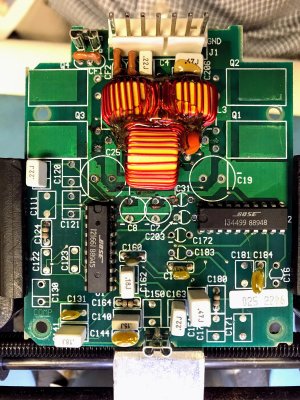I replaced the capacitors in my subwoofer amp per this excellent thread. I verified the capacitors I was replacing were the correct value and voltage rating, confirming the information in that thread. I re-assembled everything and plugged it in, but I'm not getting any sound output. It's an improvement, as before I was getting the typical high pitched screech.
Using a lab supply and signal generator (800 Hz, 1V pk-pk sine wave) I probed around the amp while it was powered up. I verified that the input signal is reaching pins 1 and 2 of the left vertical IC. I also verified that the FETs are receiving a gate drive signal and are switching at ~140 kHz, but seem to be stuck at 50% duty cycle regardless of amp input. This seems to indicate that either one of the ICs are bad, or a trace connecting the 2 ICs got destroyed when the electrolyte leaked out of one of the capacitors. I repaired one trace, visible under the large inductor in the pictures below, with a fly wire on the bottom of the board.
1. What is a typical input signal magnitude to the amps? I don't want to overdrive the input and blow it out during testing
2. Does anyone (@Briank [MENTION=25737]Kaz-kzukNA1[/MENTION]) have pictures of the top of a bare board so I can verify continuity without pulling everything off? I'm thinking I may have missed a destroyed trace under one of the inductors or ICs
3. Does anyone know the signal path from the first IC to the second IC? If either IC is dead, I may be looking for a new amp all together.

Using a lab supply and signal generator (800 Hz, 1V pk-pk sine wave) I probed around the amp while it was powered up. I verified that the input signal is reaching pins 1 and 2 of the left vertical IC. I also verified that the FETs are receiving a gate drive signal and are switching at ~140 kHz, but seem to be stuck at 50% duty cycle regardless of amp input. This seems to indicate that either one of the ICs are bad, or a trace connecting the 2 ICs got destroyed when the electrolyte leaked out of one of the capacitors. I repaired one trace, visible under the large inductor in the pictures below, with a fly wire on the bottom of the board.
1. What is a typical input signal magnitude to the amps? I don't want to overdrive the input and blow it out during testing
2. Does anyone (@Briank [MENTION=25737]Kaz-kzukNA1[/MENTION]) have pictures of the top of a bare board so I can verify continuity without pulling everything off? I'm thinking I may have missed a destroyed trace under one of the inductors or ICs
3. Does anyone know the signal path from the first IC to the second IC? If either IC is dead, I may be looking for a new amp all together.

Last edited:




